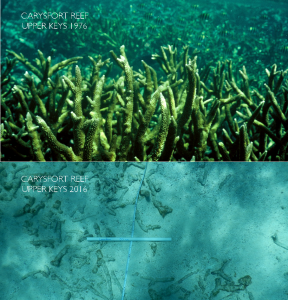Researchers say reefs are dissolving sooner than previously thought
2 May 2016
WASHINGTON, DC—Limestone that forms the foundation of coral reefs along the Florida Reef Tract is dissolving during the fall and winter months on many reefs in the Florida Keys, according to a new study. The research showed that the upper Florida Keys were the most impacted by the annual loss of reef.

The extensive thickets of staghorn corals at Carysfort Reef, approximately six nautical miles east of Key Largo, Florida, are gone today and replaced by a structure-less bottom littered with the decaying skeletons of staghorn coral.
Credit: Chris Langdon.
Each year the oceans absorb carbon dioxide from the atmosphere and become more acidic, a process called ocean acidification. Projections, based largely on laboratory studies, led scientists to predict that ocean pH would not fall low enough to cause reefs to start dissolving until 2050-2060.
For two years, the researchers collected water samples along the 200-kilometer (124-mile) stretch of the Florida Reef Tract north of Biscayne National Park to the Looe Key National Marine Sanctuary. The data provide a snapshot on the health of the reefs and establish a baseline from which future changes can be judged.
The results showed reef dissolution is a significant problem on reefs in the upper Keys with the loss of limestone exceeding the amount the corals are able to produce on an annual basis. As a result, these reefs are expected to begin wasting away, leaving less habitat for commercially- and recreationally-important fish species. Florida Keys’ reefs have an estimated asset value of $7.6 billion. The study was accepted for publication today in the journal Global Biogeochemical Cycles, a journal of the American Geophysical Union.
In the natural scheme of things in the spring and summer months, environmental conditions in the ocean such as water temperature, light and seagrass growth are favorable for the growth of coral limestone. During the fall and winter, low light and temperature conditions along with the annual decomposition of seagrass result in a slowing, or small-scale loss of reef growth.
However, as atmospheric carbon dioxide is absorbed by seawater, ocean pH declines. The result is that the natural summer growth cycle of coral is no longer large enough to offset the effects of dissolution from ocean acidification.
“We don’t have as much time as we previously thought,” said Chris Langdon, professor of marine biology and ecology at the University of Miami Rosensteil School of Marine & Atmospheric Science and a senior author of the study. “The reefs are beginning to dissolve away.”
“This is one more reason why we need to get serious about reducing carbon dioxide emission sooner rather than later,” Langdon said.
The data for the study were collected in 2009-2010. The researchers suggest that a more recent analysis should be conducted to see how the reefs are faring today.
“The worst bleaching years on record in the Florida Keys were 2014-2015, so there’s a chance the reefs could be worse now,” Langdon said.
###
The American Geophysical Union is dedicated to advancing the Earth and space sciences for the benefit of humanity through its scholarly publications, conferences, and outreach programs. AGU is a not-for-profit, professional, scientific organization representing more than 60,000 members in 139 countries. Join the conversation on Facebook, Twitter, YouTube, and our other social media channels.
The University of Miami is one of the largest private research institutions in the southeastern United States. The University’s mission is to provide quality education, attract and retain outstanding students, support the faculty and their research, and build an endowment for University initiatives. Founded in the 1940s, the Rosenstiel School of Marine & Atmospheric Science has grown into one of the world’s premier marine and atmospheric research institutions. Offering dynamic interdisciplinary academics, the Rosenstiel School is dedicated to helping communities to better understand the planet, participating in the establishment of environmental policies, and aiding in the improvement of society and quality of life.
Notes for Journalists
Journalists and public information officers (PIOs) of educational and scientific institutions who have registered with AGU can download a PDF copy of the article by clicking on this link: http://onlinelibrary.wiley.com/doi/10.1002/2015GB005327/abstract
Or, you may order a copy of the final paper by emailing a request to Lauren Lipuma at [email protected].
Please provide your name, the name of your publication, and your phone number.
Neither the paper nor this press release is under embargo.
“Dynamics of carbonate chemistry, production and calcification of the Florida Reef Tract (2009-2010): evidence for seasonal dissolution”
Authors:
Nancy Muehllehner, Chris Langdon, Alyson Venti: Rosenstiel School of Marine and Atmospheric Science, University of Miami, Miami, Florida, U.S.A.;
David Kadko: Florida International University, Miami, Florida, U.S.A.
Contact Information for the Authors:
Chris Langdon: +1 (305) 421-4614, [email protected]
Lauren Lipuma
+1 (202) 777-7396
[email protected]
University of Miami Contact:
Diana Udel
+1 (305) 421-4704
[email protected]